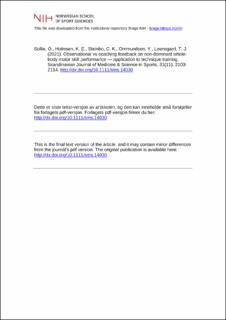| dc.contributor.author | Sollie, Ove | |
| dc.contributor.author | Holmsen, Kristian Erik | |
| dc.contributor.author | Steinbo, Christian Kay | |
| dc.contributor.author | Ommundsen, Yngvar | |
| dc.contributor.author | Losnegard, Thomas Johansen | |
| dc.date.accessioned | 2022-09-14T09:54:57Z | |
| dc.date.available | 2022-09-14T09:54:57Z | |
| dc.date.created | 2021-09-01T09:30:11Z | |
| dc.date.issued | 2021 | |
| dc.identifier.citation | Scandinavian Journal of Medicine & Science in Sports. 2021, 31(11), 2103-2114. | en_US |
| dc.identifier.issn | 0905-7188 | |
| dc.identifier.uri | https://hdl.handle.net/11250/3017761 | |
| dc.description | Dette er siste tekst-versjon av artikkelen, og den kan inneholde små forskjeller fra forlagets pdf-versjon. Forlagets pdf-versjon finner du her: http://dx.doi.org/10.1016/j.euf.2021.09.003 / This is the final text version of the article, and it may contain minor differences
from the journal's pdf version. The original publication is available here: http://dx.doi.org/10.1016/j.euf.2021.09.003 | en_US |
| dc.description.abstract | We studied the effect of peer- and self-observational feedback versus coaching feedback during technique training on performance in competitive adolescent cross-country skiers. Fifty-four skiers (14.3 ± 0.6 years) were divided into a control group and three intervention groups (dyad practice, video, or coaching feedback), which practiced in the asymmetrical uphill sub-technique G2 on one side (non-dominant side), but not the other (dominant side) for 6 × 30 min over a 5 weeks period, on roller skis outdoors. High-speed performance and skiing economy were assessed on a roller ski treadmill before and after the intervention, and a questionnaire was answered post-intervention. The video feedback (p = .025, d = .65) and coaching feedback (p = .007, d = .89) groups improved high-speed performance during the intervention and an ANCOVA showed a tendency for different change scores between interventions (F3,49 = 2.5, p = .068, urn:x-wiley:09057188:media:sms14030:sms14030-math-0001 = .134), with a difference between the coaching feedback and dyad practice (p = .05). No change was seen in skiing economy in any group. Coaching feedback ranked higher on enjoyment compared with dyad practice (p < .001) and led to higher self-perception of improved technique compared with the control group (p = .038). Overall, feedback from a competent coach seems better than observation for improving performance in young athletes, although self-observation through video with attentional cues seems a promising tool for increasing individual feedback when coaching large groups. | en_US |
| dc.language.iso | eng | en_US |
| dc.subject | dyad practice | en_US |
| dc.subject | motor learning | en_US |
| dc.subject | motor performance | en_US |
| dc.subject | practice efficiency | en_US |
| dc.subject | talent development | en_US |
| dc.subject | video feedback | en_US |
| dc.title | Observational vs coaching feedback on non-dominant whole-body motor skill performance — application to technique training | en_US |
| dc.title.alternative | Observational vs coaching feedback on non-dominant whole-body motor skill performance — application to technique training | en_US |
| dc.type | Peer reviewed | en_US |
| dc.type | Journal article | en_US |
| dc.description.version | acceptedVersion | en_US |
| dc.source.pagenumber | 12 | en_US |
| dc.source.journal | Scandinavian Journal of Medicine & Science in Sports | en_US |
| dc.identifier.doi | 10.1111/sms.14030 | |
| dc.identifier.cristin | 1930315 | |
| dc.description.localcode | Institutt for fysisk prestasjonsevne / Department of Physical Performance | en_US |
| cristin.ispublished | true | |
| cristin.fulltext | postprint | |
| cristin.qualitycode | 2 | |
